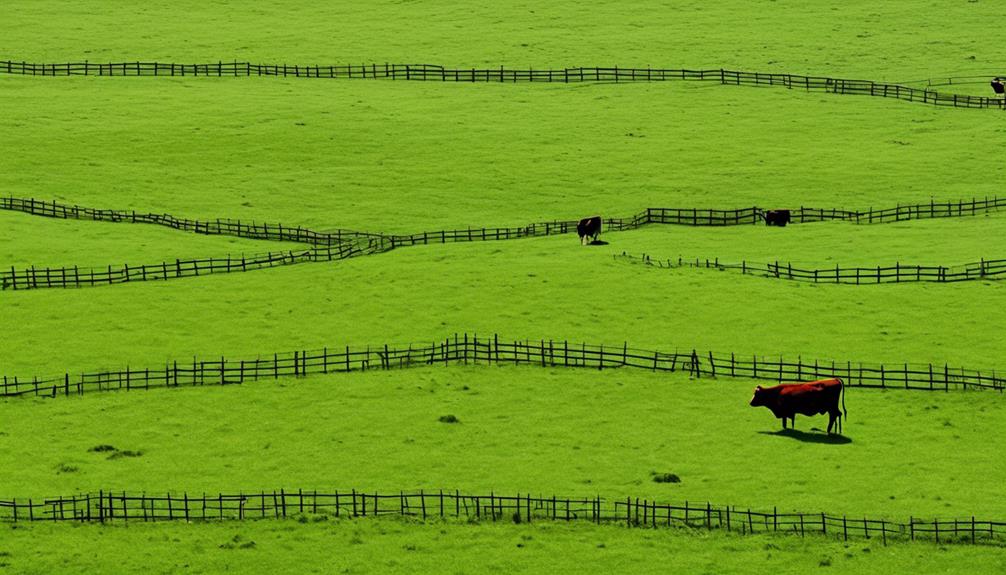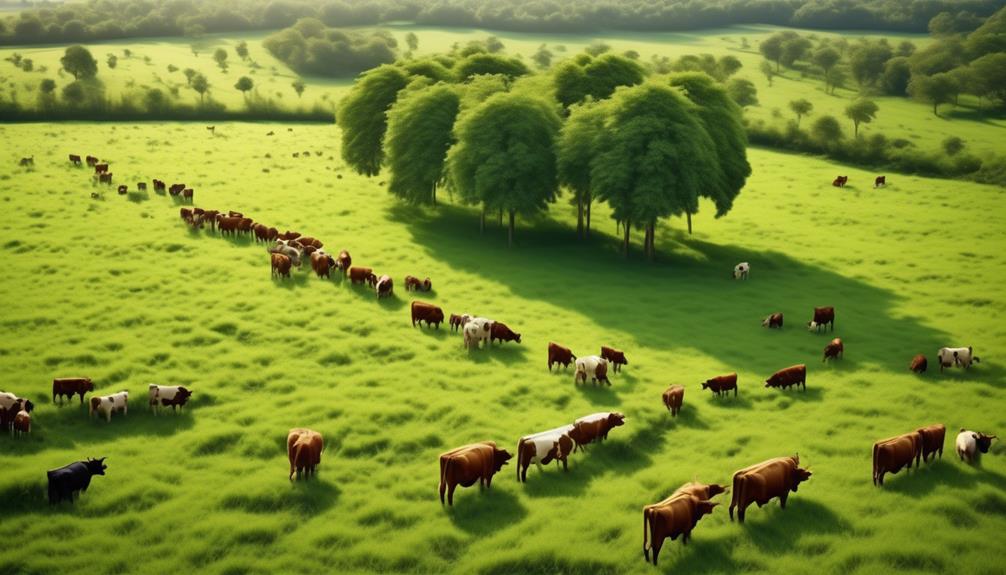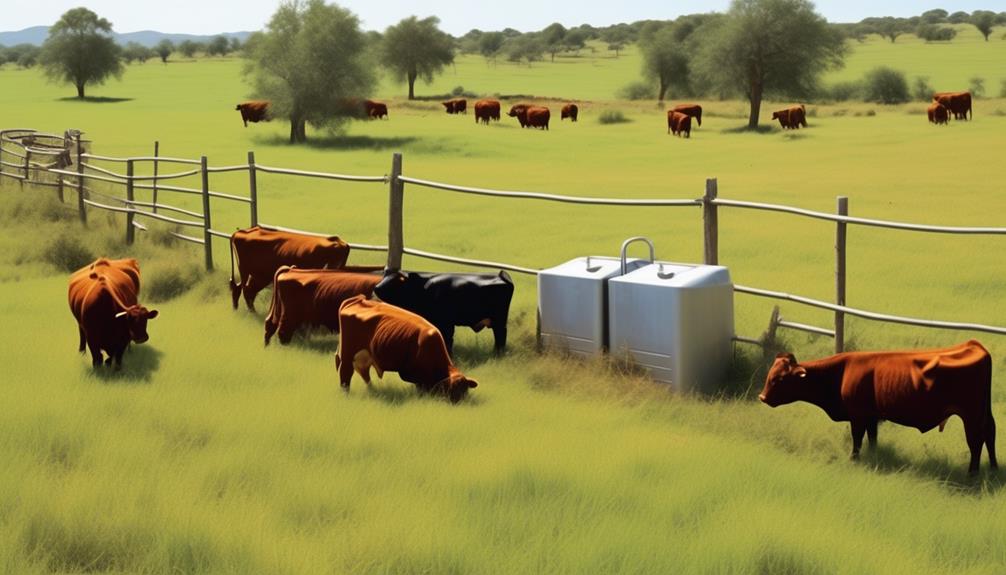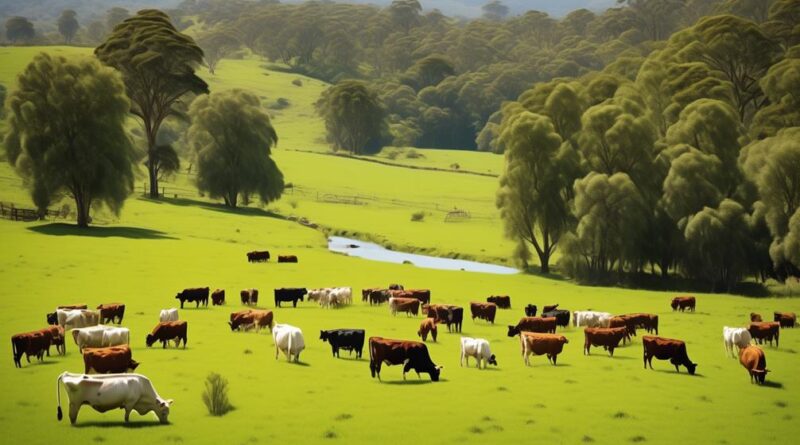10 Sustainable Grazing Practices for Cattle Farming
Imagine your cattle farm as a symphony, where each grazing practice is a note coming together to create a harmonious melody.
From rotational grazing to silvopasture, there are various sustainable practices that can elevate the health of your herd and the land they graze on.
But what are these practices, and how can they transform your cattle farming operation into a sustainable and thriving enterprise?
Let's explore 10 essential sustainable grazing practices that can revolutionize the way you manage your cattle and the environment they depend on.
Rotational Grazing

To improve pasture health and maximize forage utilization, rotational grazing involves dividing your grazing area into smaller paddocks and regularly rotating your cattle between them. This practice has significant benefits for soil health and biodiversity conservation on your farm.
By rotating your cattle through smaller paddocks, you prevent overgrazing in specific areas, allowing the pasture to recover and the soil to maintain its health. The constant movement of cattle also helps distribute their manure more evenly, which improves soil fertility and reduces the risk of nutrient runoff.
In addition to soil health, rotational grazing plays a vital role in biodiversity conservation. When cattle are continuously grazing in the same area, they can have a negative impact on the diversity of plant species. However, by rotating them through different paddocks, you allow plants to recover and grow, promoting a more diverse and resilient ecosystem. This, in turn, supports a wider range of wildlife and insects, contributing to the overall health of the grazing area.
Implementing rotational grazing on your farm not only benefits your cattle but also has a positive impact on the environment. By improving soil health and promoting biodiversity conservation, you're creating a more sustainable and balanced ecosystem for both your livestock and the surrounding environment.
Managed Intensive Grazing
By implementing managed intensive grazing, you can further optimize the health of your pasture and the well-being of your cattle, building upon the principles of rotational grazing. Managed intensive grazing involves dividing pastures into smaller paddocks and carefully controlling the timing and intensity of grazing. This approach allows for more efficient use of available forage and promotes healthier pastures and livestock.
Here are some key points to consider when implementing managed intensive grazing:
- Herd movement
Regularly moving your cattle from one paddock to another encourages even grazing and prevents overgrazing in specific areas. This rotational movement also allows for rest and recovery of grazed areas, promoting the overall health and productivity of the pasture.
- Pasture allocation
Allocating specific areas for grazing for a set period helps prevent selective grazing and allows forage to recover. This ensures that all areas of the pasture are utilized, leading to more uniform pasture growth and healthier forage.
- Monitoring and flexibility
Regularly monitoring the condition of the pasture and the health of the cattle is crucial. This allows for adjustments to be made in the grazing schedule or pasture allocation as needed, ensuring that the system remains sustainable and beneficial for both the pasture and the cattle.
Implementing managed intensive grazing can significantly improve the productivity and sustainability of your cattle farming operation while enhancing the health of your pasture and livestock.
Silvopasture

Incorporate trees into your grazing system to create a sustainable and integrated silvopasture environment. Silvopasture is a form of agroforestry that offers numerous benefits for cattle farming. Tree integration within pastures provides shade for livestock, reducing heat stress and improving animal welfare. Additionally, the presence of trees can enhance the overall biodiversity of the grazing area, promoting a healthier ecosystem.
Incorporating trees into your grazing system not only benefits the cattle but also offers advantages for the environment. Trees contribute to carbon sequestration, helping to mitigate climate change. They also aid in soil conservation, preventing erosion and improving water retention. These agroforestry benefits can lead to more resilient and sustainable cattle farming practices.
Furthermore, the integration of trees within pastures can provide supplementary forage for cattle. Certain tree species, such as leguminous trees, can offer nutritious browse for livestock, reducing the reliance on external feed sources. This not only lowers costs but also promotes a more self-sufficient and sustainable approach to cattle farming.
Riparian Grazing Management
As you expand your sustainable grazing practices, consider the management of riparian areas to further enhance the environmental benefits and overall well-being of your cattle farming operation. Implementing effective riparian grazing management is crucial for maintaining healthy waterways and preserving the ecological balance of your farm.
Here are some key points to consider:
- Streambank Erosion: Addressing streambank erosion is essential in riparian grazing management. By strategically placing fencing and buffer zones along waterways, you can prevent excessive trampling and soil disturbance by cattle, thereby reducing erosion and maintaining the integrity of stream banks.
- Riparian Restoration: Engaging in riparian restoration efforts can greatly improve the health of your waterways. Planting native vegetation along riparian zones can help stabilize soil, filter pollutants, and provide shade for aquatic habitats. Moreover, restoring these areas can contribute to overall biodiversity and create a more resilient ecosystem on your farm.
- Water Quality Protection: Proper riparian grazing management plays a crucial role in protecting water quality. By minimizing direct cattle access to streams and implementing alternative water sources, you can significantly reduce the risk of water contamination and ensure that your livestock have access to clean, safe drinking water.
Forage Diversity

Considering the diverse nutritional needs of your cattle, ensuring a wide variety of forage species is available in your grazing areas is essential for promoting their health and overall productivity. Forage diversity plays a crucial role in maintaining the soil health of your grazing areas. Different forage species have varying root structures and growth habits, which can help improve soil structure, reduce erosion, and enhance nutrient cycling. By incorporating a diverse range of forage species, you can contribute to the overall health and resilience of the soil on your grazing land.
Moreover, forage diversity is paramount in achieving a balanced diet for your cattle. Different forage species offer varying nutritional profiles, and by providing a diverse range of forage options, you can help ensure that your cattle have access to a wide array of essential nutrients. This is particularly important for maintaining the nutritional balance necessary for the overall health and well-being of your herd.
Grazing Rest Periods
Ensuring adequate rest periods for your grazing areas is crucial for maintaining the health and productivity of your cattle. Grazing frequency directly impacts vegetation recovery, and allowing for appropriate rest periods is essential for ensuring the long-term health of your pastures. Here are some important points to consider:
- Grazing Frequency:
Proper rest periods between grazing sessions allow plants to recover and regrow. This helps maintain the overall health and vigor of the pasture, ensuring a continuous and sustainable food supply for your cattle.
- Vegetation Recovery:
Allowing adequate rest periods enables the vegetation to replenish its energy reserves, resulting in improved forage quality. This, in turn, contributes to the overall well-being and productivity of your cattle.
- Soil Health and Nutrient Cycling:
Rest periods play a key role in maintaining soil health and promoting nutrient cycling. Giving the soil and vegetation time to recover and grow increases organic matter and enhances nutrient availability, ultimately benefiting the entire ecosystem.
Water Access Management

You need to manage water access for your cattle in a way that ensures hydration and promotes sustainable land use. Drought preparedness is critical in ensuring that your cattle have reliable access to water, especially during dry periods. Implementing strategies such as water catchment systems, storage facilities, and rotational grazing can help mitigate the impact of drought on water availability. By planning ahead and having contingency measures in place, you can better prepare for water scarcity and maintain the health of your herd.
Water conservation is equally important for sustainable grazing practices. Implementing measures such as installing water-efficient troughs and pipelines, monitoring water usage, and repairing leaks can significantly reduce water wastage and ensure efficient utilization of this precious resource. Furthermore, managing grazing areas to prevent soil erosion and maintaining riparian buffers can help preserve water quality and ecosystem health. By minimizing pollutants and sedimentation in water sources, you can contribute to the overall well-being of the surrounding environment.
Ensuring good water quality is essential for the health of your cattle and the sustainability of the land. Regular testing of water sources for contaminants and implementing appropriate water treatment methods, if necessary, can help safeguard the well-being of your herd. Additionally, promoting ecosystem health by protecting water sources from overgrazing and ensuring proper vegetation cover along waterways can contribute to the overall resilience of the grazing ecosystem.
Monitoring and Evaluation
To ensure the effectiveness of your sustainable grazing practices, it's essential to establish monitoring and evaluation procedures for water access management and overall ecosystem health. This involves systematically tracking and assessing the impact of your grazing practices on the environment and the well-being of your cattle.
Here's how you can effectively monitor and evaluate your sustainable grazing practices:
- Regular Data Analysis: Implement a system for collecting and analyzing data related to grazing patterns, water usage, and vegetation health. This will provide valuable insights into the impact of your grazing practices on the ecosystem and help in making informed decisions for sustainable land management.
- Performance Tracking: Set up clear performance indicators to monitor the health and behavior of your cattle, as well as the overall condition of the grazing area. This can include tracking weight gain, water intake, and any signs of overgrazing or environmental stress. By closely monitoring these key indicators, you can make timely adjustments to your grazing practices to ensure the well-being of your cattle and the sustainability of the land.
- Ecosystem Health Assessment: Conduct regular assessments of the ecosystem health, including soil quality, plant diversity, and water availability. By integrating these assessments into your monitoring and evaluation framework, you can gauge the long-term impact of your grazing practices on the overall health of the land and make informed decisions to promote sustainable grazing.
Frequently Asked Questions
How Can Cattle Farmers Incorporate Sustainable Grazing Practices Into Their Overall Farm Management Plan?
You can incorporate sustainable grazing practices by integrating innovative technologies and holistic management into your farm plan. Focus on improving soil health and raising grass-fed beef. This approach will benefit both your cattle and the environment.
Are There Any Specific Government Regulations or Incentives for Implementing Sustainable Grazing Practices on Cattle Farms?
There are government incentives available for implementing sustainable grazing practices on cattle farms. However, there are also regulatory challenges to consider. It's important to research and understand the specific requirements in your area.
What Are Some Alternative Grazing Systems That Can Be Used in Conjunction With Traditional Rotational and Intensive Grazing Methods?
When considering alternative grazing systems, you may find silvopasture systems and managed intensive grazing beneficial. These grazing management techniques can enhance drought resilience. Implementing these methods can optimize your cattle farming practices.
How Can Farmers Balance the Need for Cattle to Graze With the Need to Protect Natural Habitats and Wildlife in the Grazing Area?
You can balance conservation and cattle welfare by implementing strategic grazing management. Protect wildlife habitat by rotating grazing areas and using exclusion fencing. This ensures cattle have access to fresh forage while preserving natural habitats for wildlife.
Are There Any Specific Considerations for Implementing Sustainable Grazing Practices in Different Climate or Geographic Regions?
When implementing sustainable grazing practices in different climate or geographic regions, consider climate adaptations to ensure the well-being of cattle and address geographic challenges to protect natural habitats and wildlife. Adaptation is key.
Conclusion
By implementing these sustainable grazing practices, you can improve the health of your cattle, the productivity of your land, and the overall sustainability of your farming operation. Remember to rotate grazing areas, manage intensive grazing, incorporate silvopasture, and prioritize forage diversity.
It's important to monitor and evaluate the effectiveness of these practices and make adjustments as needed. With these strategies in place, you can contribute to a more sustainable and environmentally-friendly cattle farming industry.
